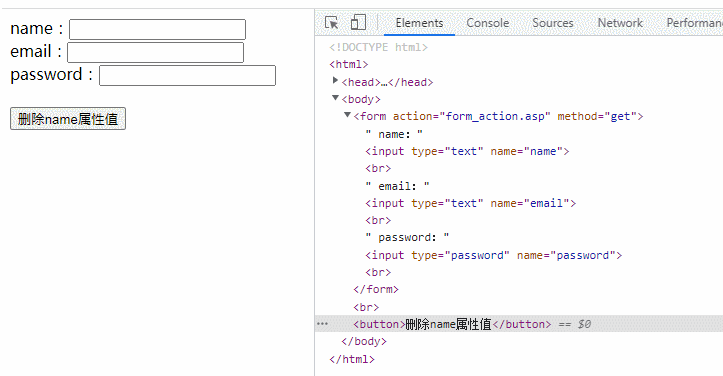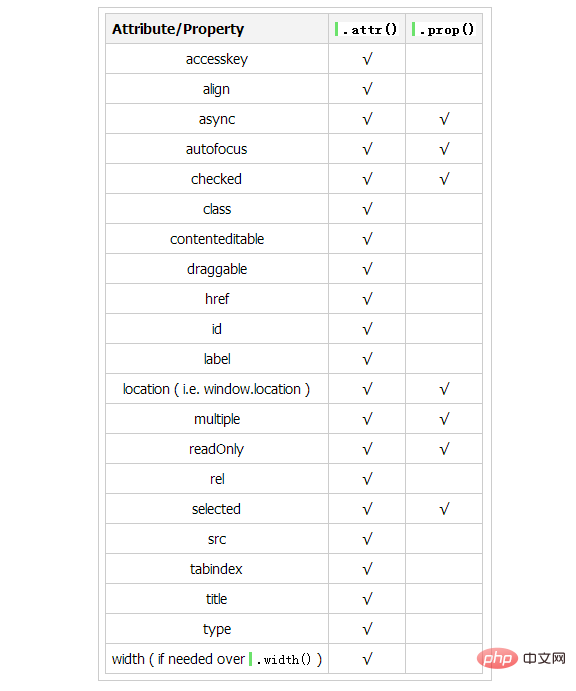How to delete the name attribute value in jquery
Two methods: 1. Use attr() to modify the value of the name attribute and set it to an empty character. The syntax is "$(selector).attr("name","");". 2. Use prop() to modify the value of the name attribute and set it to an empty character. The syntax is "$(selector).prop("name","");".

The operating environment of this tutorial: windows7 system, jquery3.6.1 version, Dell G3 computer.
HTML name attribute
name is mainly an attribute that only exists in form elements.
name attribute specifies the name of the form element (eg input). The
name attribute is used to identify the form data after it is submitted to the server or to reference the form data through JavaScript on the client.
Note: Only form elements with the name attribute set can pass their values when submitting the form.
jquery deletes the name attribute value
Deleting the name attribute value can be understood as clearing the name attribute value, that is, setting it to an empty character.
JQuery provides two functions for setting attribute values:
attr()
prop()
Method 1: Use attr() to set attribute values
attr() syntax:
//单个属性
$(selector).attr("属性名","新属性值");
//多个个属性
$(selector).attr({属性1:"新值",属性2:"新值"....});Example: Modify the value of the name attribute and set it to an empty character
<!DOCTYPE html>
<html>
<head>
<meta charset="utf-8" />
<script src="js/jquery-3.6.1.min.js"></script>
<script>
$(document).ready(function() {
$("button").click(function() {
$("input").attr("name","");
});
});
</script>
</head>
<body>
<form action="form_action.asp" method="get">
<p>name:<input type="text" name="fullname" /></p>
<p>email:<input type="text" name="email" /></p>
</form>
<button>删除name属性值</button>
</body>
</html>
Method 2: Use prop() to set the attribute value
prop() syntax:
//单个属性
$(selector).prop("属性名","新值");
//多个个属性
$(selector).prop({属性1:"新值",属性2:"新值"....});Example: Modify the value of the name attribute and set it to an empty character
<!DOCTYPE html>
<html>
<head>
<meta charset="utf-8" />
<script ></script>
<script>
$(document).ready(function() {
$("button").click(function() {
$("input").prop("name","");
});
});
</script>
</head>
<body>
<form action="form_action.asp" method="get">
name:<input type="text" name="name" /><br />
email:<input type="text" name="email" /><br />
password:<input type="password" name="password" /><br />
</form><br />
<button>删除name属性值</button>
</body>
</html>
jquery prop () and attr() difference:
attr() definition
attr() method sets or returns the attributes and values of the selected element .
When this method is used to return an attribute value, the value of the first matching element is returned.
When this method is used to set attribute values, one or more attribute/value pairs are set for the matching element.
prop()Definition
The prop() method sets or returns the properties and values of the selected element.
When this method is used to return an attribute value, the value of the first matching element is returned.
When this method is used to set attribute values, one or more attribute/value pairs are set for the set of matching elements.
$('').attr()Returns the html object$(' ').prop()returns the DOM object
prop()
method operates radio (checkbox) and the like When a control is selected, the selected value of the control will also change accordingly. That is, you can control both its selection and its deselection;
is similar to $("...").attr("checked"); returns true or false
If there is a corresponding attribute, the attribute is returned. If not, an empty string is returned.
attr():
Method operation## When controls such as #adio (checkbox) are selected, the selected value of the control will not change accordingly. That is, you can only control its selection, but not its deselection;
$("...").attr("checked");The returned value is 'checked' or undefined
Usage scenarios of attr and prop:
1 .Add the attribute name and the attribute will take effect. You should use prop();2. If there are two attributes, true and false, use prop(); (such as 'checked', 'selected', 'disabled', etc. ) 3. For others, use attr();Officially recommended use:
jQuery video Tutorial、web front-end video】
The above is the detailed content of How to delete the name attribute value in jquery. For more information, please follow other related articles on the PHP Chinese website!

Hot AI Tools

Undresser.AI Undress
AI-powered app for creating realistic nude photos

AI Clothes Remover
Online AI tool for removing clothes from photos.

Undress AI Tool
Undress images for free

Clothoff.io
AI clothes remover

AI Hentai Generator
Generate AI Hentai for free.

Hot Article

Hot Tools

Notepad++7.3.1
Easy-to-use and free code editor

SublimeText3 Chinese version
Chinese version, very easy to use

Zend Studio 13.0.1
Powerful PHP integrated development environment

Dreamweaver CS6
Visual web development tools

SublimeText3 Mac version
God-level code editing software (SublimeText3)

Hot Topics
 Detailed explanation of jQuery reference methods: Quick start guide
Feb 27, 2024 pm 06:45 PM
Detailed explanation of jQuery reference methods: Quick start guide
Feb 27, 2024 pm 06:45 PM
Detailed explanation of jQuery reference method: Quick start guide jQuery is a popular JavaScript library that is widely used in website development. It simplifies JavaScript programming and provides developers with rich functions and features. This article will introduce jQuery's reference method in detail and provide specific code examples to help readers get started quickly. Introducing jQuery First, we need to introduce the jQuery library into the HTML file. It can be introduced through a CDN link or downloaded
 How to remove the height attribute of an element with jQuery?
Feb 28, 2024 am 08:39 AM
How to remove the height attribute of an element with jQuery?
Feb 28, 2024 am 08:39 AM
How to remove the height attribute of an element with jQuery? In front-end development, we often encounter the need to manipulate the height attributes of elements. Sometimes, we may need to dynamically change the height of an element, and sometimes we need to remove the height attribute of an element. This article will introduce how to use jQuery to remove the height attribute of an element and provide specific code examples. Before using jQuery to operate the height attribute, we first need to understand the height attribute in CSS. The height attribute is used to set the height of an element
 How to use PUT request method in jQuery?
Feb 28, 2024 pm 03:12 PM
How to use PUT request method in jQuery?
Feb 28, 2024 pm 03:12 PM
How to use PUT request method in jQuery? In jQuery, the method of sending a PUT request is similar to sending other types of requests, but you need to pay attention to some details and parameter settings. PUT requests are typically used to update resources, such as updating data in a database or updating files on the server. The following is a specific code example using the PUT request method in jQuery. First, make sure you include the jQuery library file, then you can send a PUT request via: $.ajax({u
 jQuery Tips: Quickly modify the text of all a tags on the page
Feb 28, 2024 pm 09:06 PM
jQuery Tips: Quickly modify the text of all a tags on the page
Feb 28, 2024 pm 09:06 PM
Title: jQuery Tips: Quickly modify the text of all a tags on the page In web development, we often need to modify and operate elements on the page. When using jQuery, sometimes you need to modify the text content of all a tags in the page at once, which can save time and energy. The following will introduce how to use jQuery to quickly modify the text of all a tags on the page, and give specific code examples. First, we need to introduce the jQuery library file and ensure that the following code is introduced into the page: <
 In-depth analysis: jQuery's advantages and disadvantages
Feb 27, 2024 pm 05:18 PM
In-depth analysis: jQuery's advantages and disadvantages
Feb 27, 2024 pm 05:18 PM
jQuery is a fast, small, feature-rich JavaScript library widely used in front-end development. Since its release in 2006, jQuery has become one of the tools of choice for many developers, but in practical applications, it also has some advantages and disadvantages. This article will deeply analyze the advantages and disadvantages of jQuery and illustrate it with specific code examples. Advantages: 1. Concise syntax jQuery's syntax design is concise and clear, which can greatly improve the readability and writing efficiency of the code. for example,
 Use jQuery to modify the text content of all a tags
Feb 28, 2024 pm 05:42 PM
Use jQuery to modify the text content of all a tags
Feb 28, 2024 pm 05:42 PM
Title: Use jQuery to modify the text content of all a tags. jQuery is a popular JavaScript library that is widely used to handle DOM operations. In web development, we often encounter the need to modify the text content of the link tag (a tag) on the page. This article will explain how to use jQuery to achieve this goal, and provide specific code examples. First, we need to introduce the jQuery library into the page. Add the following code in the HTML file:
 How to tell if a jQuery element has a specific attribute?
Feb 29, 2024 am 09:03 AM
How to tell if a jQuery element has a specific attribute?
Feb 29, 2024 am 09:03 AM
How to tell if a jQuery element has a specific attribute? When using jQuery to operate DOM elements, you often encounter situations where you need to determine whether an element has a specific attribute. In this case, we can easily implement this function with the help of the methods provided by jQuery. The following will introduce two commonly used methods to determine whether a jQuery element has specific attributes, and attach specific code examples. Method 1: Use the attr() method and typeof operator // to determine whether the element has a specific attribute
 Understand the role and application scenarios of eq in jQuery
Feb 28, 2024 pm 01:15 PM
Understand the role and application scenarios of eq in jQuery
Feb 28, 2024 pm 01:15 PM
jQuery is a popular JavaScript library that is widely used to handle DOM manipulation and event handling in web pages. In jQuery, the eq() method is used to select elements at a specified index position. The specific usage and application scenarios are as follows. In jQuery, the eq() method selects the element at a specified index position. Index positions start counting from 0, i.e. the index of the first element is 0, the index of the second element is 1, and so on. The syntax of the eq() method is as follows: $("s






